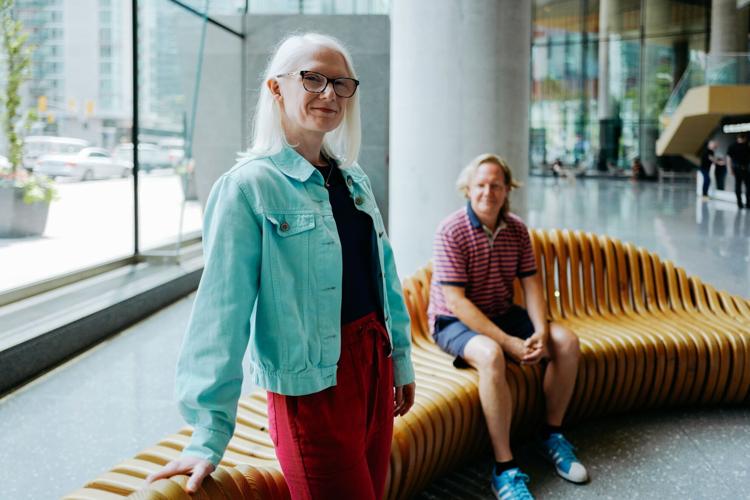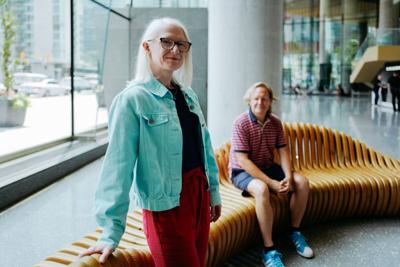When you think of Canadian television comedy high-profile hits like Emmy winner “Schitt’s Creek” or more recent entry “North of North” likely come to mind. But beyond the spotlight is a whole world of scrappy, homegrown original comedy series — shows made with a fraction of the budgets but just as much heart and creative fire.Â
Take “Pretty Blind” and “18 to 35,” two new comedies that are small in scale but big on specificity, representation and fun.
“Orphan Black” and “Slings and Arrows” make our list of standout CanCon.
“Orphan Black” and “Slings and Arrows” make our list of standout CanCon.
‘A human just living her life’
“Pretty Blind” is the first scripted original series for AMI-tv, which specializes in content for and about Canadians with disabilities.
It stars Jennie Bovard, a Nova Scotian with albinism and low vision, as Jennie Bonang, a Nova Scotian with albinism and low vision — but also a sarcastic sense of humour, a fondness for board games, a job at her local library, a love life, a fraught relationship with her family, annoying roommates, and a clueless boss. A life, in other words. And as she lives that life, she navigates obstacles from blocked sidewalks and a dearth of grocery store baskets to other people’s misunderstandings about her disability.
“My albinism, it is part of my identity, so it’s important to acknowledge it, but it’s not the whole thing,” said Bovard, who was in É«É«À² last month to promote the series alongside actor and comedian Jonathan Torrens, who co-wrote and directed “Pretty Blind.” It has already been renewed for a second season.
Bovard was born with the type of albinism that results in a lack of pigment in her skin, hair and eyes; she’s highly sensitive to light and highly susceptible to sunburn and skin cancer. “I’m a professional pale person and a professional pedestrian,” Bovard said, since she’s not allowed to drive (although she’s a marathon runner and can ride a bike, as she does in “Pretty Blind”‘s credits).
“How people with albinism or albinistic qualities have been portrayed in entertainment to date has not necessarily been flattering. (What’s) so unique and so impactful with our show is that we’re depicting someone with albinism as a human being who is just living her life.”
The series grew from Bovard’s four-season podcast, “Low Vision Moments,” in which she shared stories about the embarrassing and frustrating — but ultimately funny — things that happened to her and other people with blindness or low vision.
When AMI decided to turn it into a series it brought on Torrens, known for shows like “Trailer Park Boys,” “Mr. D,” “Street Cents” and “Jonovision,” and Mark Forward, the actor, writer and standup comedian best known as Coach in “Letterkenny,” who serves as showrunner.
“My first reaction was, ‘Is there anything inherently funny about blindness?’” said Torrens.
“As a sighted person, it feels like not my story to tell, but I do like a good joke as much as the next person and it took meeting Jennie for about 10 seconds to realize she has a very firm handle on what’s funny … She shared a couple of anecdotes that made me realize there’s lots of fodder here.”

“We’re depicting someone with albinism as a human being who is just living her life,” says Jennie Bovard, the star of “Pretty Blind,” pictured with director and co-writer Jonathan Torrens.
Michelle Mengsu Chang/É«É«À² StarReimagining how to make TV
Making a TV show about a person with low vision — starring a person with low vision — and also meant to be enjoyed by people with low vision, meant reimagining how to make a TV show.
There were adaptations on set, such as covering windows and using low-light cameras; ensuring there were clear paths through equipment; giving Bovard extra time to find her way around when that equipment had to be moved; and providing her scripts in extra-large type.
Onscreen changes included incorporating video descriptions into the scripts, rather than using a separate audio track, and dressing characters in distinct colours — Jennie wears red, for instance — so low-vision viewers could differentiate people even if they couldn’t see their faces.
It’s not easy to get Canadian shows made and noticed living next door to the U.S., but, TV executives say, it’s important to keep trying.
It’s not easy to get Canadian shows made and noticed living next door to the U.S., but, TV executives say, it’s important to keep trying.
“It’s something I’m really proud of,” Torrens said of that latter innovation, “and something that, according to AMI, they will probably use on other shows.”
Quicker yeses, less interference
This isn’t the first time Torrens has turned experiences that don’t mirror his own into television.
He also directed “Roll With It,” a comedy starring wheelchair user Brian George, and “0 to 60 Driving Academy,” which Torrens called “Atlantic Canada’s first Black family sitcom.” Those series are both on Bell Fibe’s TV1 and, alongside “Pretty Blind,” they’ve put Torrens back in touch with the creative freedom of his early career.
“The process of making a thing is the thing that I got so excited about all those years ago when I started on ‘Street Cents,’” he said. “That’s what the so-called smaller networks bring: quicker yeses, generally less interference.”
John Buffone, the supervising producer at TV1, takes pride in helping to create TV that reflects not only communities all over Canada but also diverse members of those communities — including “members of the LGBTQ-plus community, African-Canadians, Asian-Canadians, South Asian-Canadians, and people with different abilities,” he said in a video interview.
TV1 delivers roughly 150 shows per broadcast year, including dramas and unscripted entries, funded by a portion of Bell Canada’s gross TV subscriber revenue under CRTC regulations. The programming must be produced in the markets where TV1 is licensed and reflect those places. So, for instance, a show set in outer space “might be the funniest thing I’ve ever read, but it doesn’t really make sense for us,” Buffone explained.
Yet the fact that TV1 is not dependent on advertising revenue or ratings gives it a freedom that often eludes larger broadcasters.
Its budgets are “probably the catering budget for a couple of weeks on a really big show, but there’s enough space there for us to kind of shrug our shoulders, take our chances and say, ‘I don’t know if this is going to work, but what’s the worst that can happen?’ For the most part, (the shows) have worked and they have found audiences.”
In fact, Buffone said TV1’s audience is “growing in leaps and bounds. We’re offering content that is utterly unique in the television and streaming landscape. We’re filling a void, but more than that, there’s a hunger for rooting programs in real communities.”
‘We know how to do this’

Carlos Albornoz and Natalia Gracious in “18 to 35.”Â
Courtesy of Khai TranOne of the communities coming to screens via TV1 later this year is London, Ont., where “18 to 35” is set.
Creators Rahul Chaturvedi and Charlie Whalley dreamed it up on a car ride from Montreal to É«É«À². It’s set in a world Chaturvedi knows well from his solo travels in his 20s and 30s: a youth hostel.
“The great thing I found about hostels is they let you be anyone you want,” he said in a video interview.
In “18 to 35” — named for the age limit at London’s fictional Crown Jewel hostel — 30-something Indo-Canadian Misha (real-life Londoner Natalia Gracious, “Painkiller”) would rather be in New York. But losing her Wall Street job forces her to run the struggling family business after her father (Ali Hassan) abandons her to go on indefinite vacation.
Hassan (“Sort Of,” “Run the Burbs”) isn’t the only ringer involved with the show. Jean Yoon of “Kim’s Convenience” has a lead role while her “Kim’s” co-star (and “Burbs” creator) Andrew Phung is an executive producer. Veteran actor and comedian Seán Cullen has a larger-than-life guest turn in the fourth episode.
Whalley and Chaturvedi aren’t TV newbies themselves — she’s an associate producer on Netflix’s “Ginny & Georgia,” he’s a writer on Crave’s “Late Bloomer” and was a story editor on “Run the Burbs” — but this is the third project they’ve tried to get off the ground.Â
It got picked up after TV1 discovered it in a pitch competition at London’s Forest City Film Festival.

“18 to 35” creators Rahul Chaturvedi and Charlie Whalley with executive producer Luisa Alvarez Restrepo at the front desk of the fictional Crown Jewel youth hostel.
Courtesy of Khai Tran“Every year, maybe a hundred shows go to the (Canadian) networks and … maybe we get two new comedies a year,” said Chaturvedi. “I think there’s more than two funny creators in the country that should get to tell their stories.”
Buffone agrees. He sees it as TV1’s mission to support emerging Canadian talents “who can use us as a stepping stone and do great things.”
Chaturvedi and Whalley still have hopes of turning “18 to 35” into a half-hour sitcom — a “Schitt’s Creek” meets “Superstore” with a very Canadian twist — but for now, they’re grateful to TV1 and Buffone for this opportunity.
“A program like this at least lets us put our foot forward and say we know how to do this,” Chaturvedi said.
“There’s an immense amount of talent in our country that needs to shine,” he added, “and it’s unfortunate that a lot of our writers eventually shine when they start writing on American shows. We should have the option of applying our craft here, growing as artists here and staying here, (to) tell these stories that make us uniquely Canadian and are just ours to hold.”
For Torrens, it’s about having faith in those Canadian stories.
”‘Trailer Park Boys’ taught me that if it’s good people will find it. And the esthetic doesn’t matter if the words are funny, if the performances are good. That’s really, at the end of the day, what makes something compelling. So I wish the bigger networks were in a position to make more things for less money and let the people decide.”
“Pretty Blind” airs Tuesdays at 9 p.m. on AMI-tv and can be streamed on . “18 to 35” will debut on later this year.

































To join the conversation set a first and last name in your user profile.
Sign in or register for free to join the Conversation